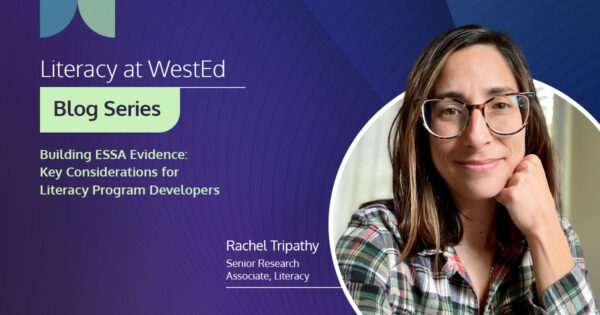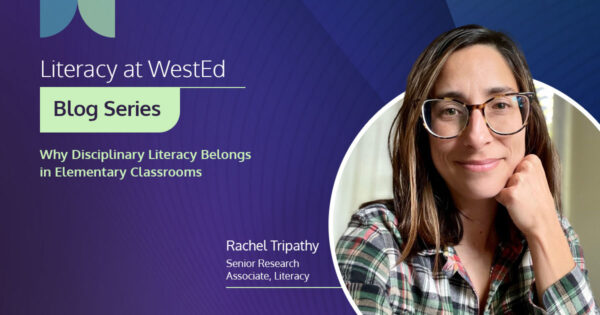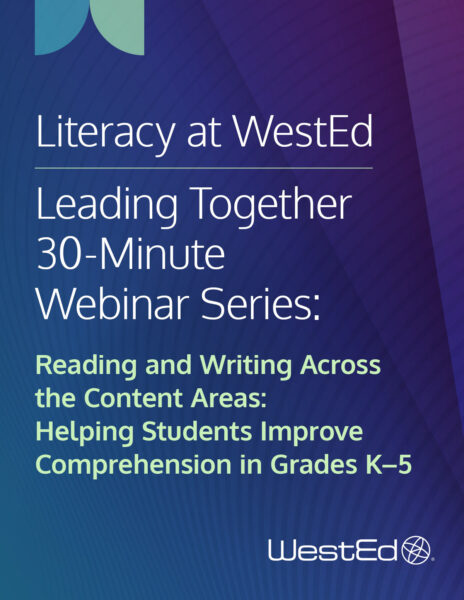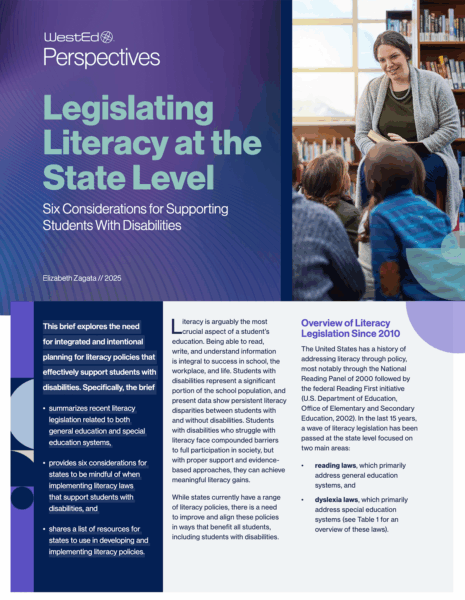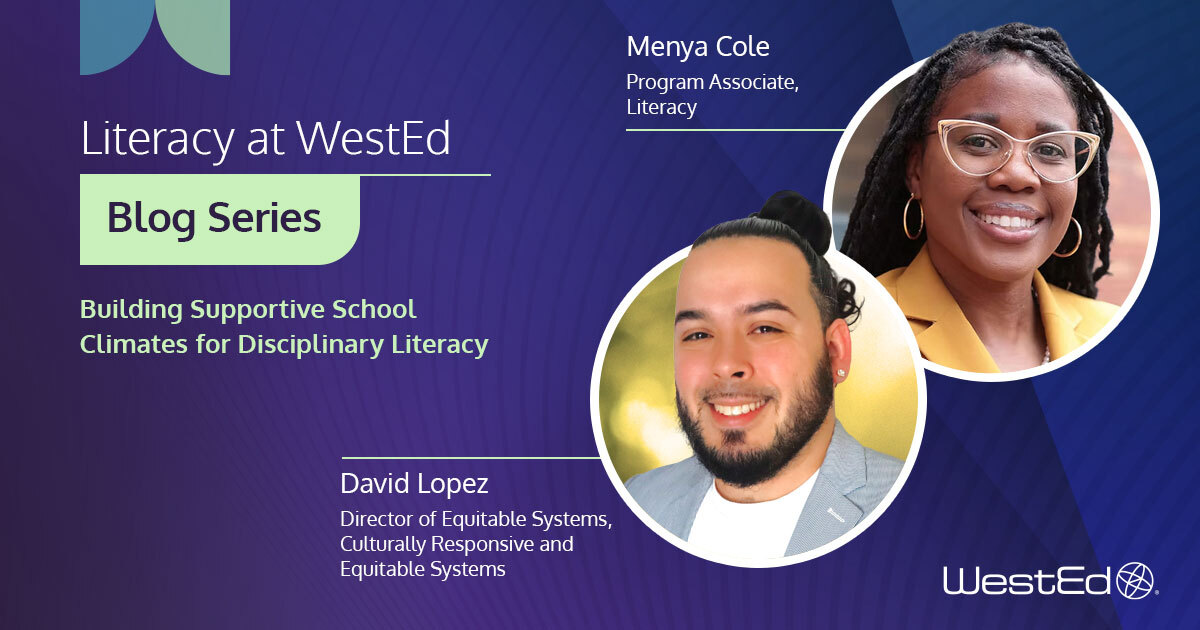
September 3, 2025
By David Lopez and Menya Cole
This blog series explores the concept of disciplinary literacy—the distinct ways of reading, writing, and communicating across academic fields such as science, history, math, and literature. Featuring actionable insights from WestEd thought leaders, the series looks at how integrating disciplinary literacy practices into elementary and secondary classrooms can support student success in school, in careers, and throughout their lives.
Students are thinkers, and they bring curiosity, analytical thinking, and expressive ideas to the classroom every day. Disciplinary literacy builds on this foundation by helping them engage with content as insiders. Rather than only learning about science, history, or other subjects, students also learn to think, read, and communicate like scientists, historians, and other disciplinary experts (Moje, 2008; Shanahan & Shanahan, 2008). This approach helps students develop a sense of belonging in academic spaces, recognizes their voices as valuable, and equips them with the tools to make meaning in discipline-specific ways (Lee, 2007; Moje, 2015). This confidence is essential for academic success and active participation in a complex world, and it grows when students have equitable opportunities to thrive.
But too often, students encounter gaps in these equitable opportunities that limit how far that confidence can take them. Opportunity gaps stem from inequitable access to high-quality, relevant instruction, not from student capacity (Paris & Alim, 2017). A school climate that supports disciplinary literacy responds to this reality by going beyond reading strategies alone to ensure that all students have meaningful opportunities to engage in disciplinary work in inclusive ways. Disciplinary literacy, especially when taught through a responsive lens, ensures that all students are invited into the intellectual work of the classroom (Muhammad, 2020). Bringing students’ cultural knowledge into the classroom enriches learning and strengthens engagement (Gay, 2018). Therefore, when educators intentionally connect to the lives and communities of students while teaching students how to engage with the tools and texts of each discipline, disparities in access to rigorous, meaningful learning begin to shrink.
To make disciplinary literacy meaningful and sustainable, instruction must be supported by the conditions in which learning takes place. When a school’s climate creates a space for students to feel seen, safe, and respected, students are more likely to take academic risks and see themselves as capable participants in the work of each discipline.
The Role of School Climate in Disciplinary Literacy
Imagine a school in which every student can explore their interests and think deeply about and within each of the disciplines they encounter. Such a school nurtures a climate that supports disciplinary literacy, enabling students to engage confidently with the unique language, routines, and literacy practices of each academic field. This environment is one in which the connections between learning and students’ own experiences are highlighted, which makes education both relevant and meaningful.
Research demonstrates that positive school climates are crucial for academic success, significantly impacting student motivation and well-being (National School Climate Council et al., 2009). A classroom in which students feel valued and respected helps foster a sense of belonging and agency and enables students to see themselves as active participants.
Substantial evidence underscores the importance of a supportive climate on student outcomes. For instance, a study in Chicago schools demonstrated that institutions characterized by strong climates and collaborative practices achieved better educational outcomes, particularly in literacy and math (Bryk et al., 2010). Similarly, findings suggest a strong correlation between positive racial climates and higher student engagement and achievement (Griffin et al., 2017).
Practical Strategies for Implementing Disciplinary Literacy
The School Level
To successfully promote disciplinary literacy, schools should implement broad initiatives across all classrooms that foster a responsive and inclusive climate. This can be achieved by adopting schoolwide programs like the Culturally Responsive Positive Behavioral Interventions and Supports (CRPBIS) model, which emphasizes reducing discipline disparities and fostering a supportive environment (Bal et al., 2012).
Additionally, teachers should be provided with ongoing professional development that prioritizes responsive teaching and the integration of literacy across academic subjects. This aligns with research findings that emphasize the benefits of a strong association between engaging environments and positive academic results (Griffin et al., 2017).
The Classroom Level
Educators should endeavor to integrate students’ personal experiences and cultural and linguistic identities into disciplinary literacy practices. This approach can significantly enhance engagement and relevance, aligning with the principles of culturally responsive education (Gay, 2018). Collaborative and inquiry-based learning models further respect and leverage the diverse backgrounds of students, with evidence showing that social–emotional learning and a positive climate improve academic outcomes across various racial groups (Jones et al., 2020).
Family and Community Engagement
Strengthening partnerships with families enriches students’ learning experiences and promotes steady literacy development at home. Additionally, schools can benefit from engaging community resources and cultural institutions, as highlighted by studies emphasizing that visible institutional diversity can lead to better academic outcomes for students of color (Levine et al., 2019).
Key Takeaways for Implementing Disciplinary Literacy
- Cultural Relevance: Integrate students’ cultural experiences into learning to boost engagement and achievement.
- Supportive Climate: Prioritize creating a safe and nurturing environment in which academic risks are encouraged.
- Feeling of Belonging: Encourage student agency and a sense of being capable participants across disciplines.
- Collaborative Learning: Use inclusive and inquiry-based models to respect diverse student backgrounds (Jones et al., 2020).
- Community Connections: Actively engage families and leverage cultural resources in educational activities for enriched learning experiences.
By fostering supportive climates, schools can empower students, helping them to become confident and skilled disciplinary readers and writers capable of navigating and excelling across various disciplines.
How We Help Educators Support Disciplinary Literacy
Cultivating inclusive school climates, integrating students’ lived experiences, and engaging families and communities are essential elements of what it takes to ensure that every student can thrive. This work is especially critical for students who have been denied access to rigorous, relevant learning opportunities. Empowering students through disciplinary literacy builds on their curiosity, fostering the self-efficacy and agency to contribute meaningfully to their communities and beyond.
A commitment to disciplinary literacy is a commitment to helping all students make sense of the world through the distinct ways knowledge is constructed in each field. When schools create affirming climates and teachers are supported with responsive, discipline-specific strategies, students begin to see themselves as learners and doers of history, science, math, literature, and the arts.
At WestEd, we support schools and districts in bringing this vision to life. We partner with educators to provide professional learning and coaching in Reading Apprenticeship and Writing Apprenticeship, approaches that help students grow as strategic readers, confident writers, and expert-like thinkers across disciplines. Together, we can ensure that every student is invited into the disciplines and equipped to transform them.
In addition, schools can utilize the WestEd Culturally Responsive School Walkthrough Tool. This resource assists school teams in assessing the incorporation of culturally responsive elements into their teaching and practice. It serves as an initial point of reference to guide and assess teachers’ growth in implementing culturally responsive practices (Powell et al., 2017). The tool gauges the degree of cultural responsiveness in elementary, middle, and high school curricula; instructional practices; and learning environments, helping educators understand CRSE practices and evaluate whether they are being effectively implemented. This insight can guide what supports might be needed at the classroom or school level.
About the Authors
David Lopez is the director of Equitable Systems on WestEd’s Culturally Responsive and Equitable Systems team. Lopez’s work is driven by the belief that every student deserves an educational system that recognizes and values their unique cultural identity. Lopez works to empower state education agencies, district leaders, and educators to dismantle systemic barriers and foster inclusive learning environments.
Menya Cole is a program associate in Literacy at WestEd. She works primarily with the Reading Apprenticeship and Writing Apprenticeship teams, helping educators nationwide implement disciplinary literacy strategies that improve student engagement and academic outcomes.
References
Bal, A., Kozleski, E. B., & Thorius, K. K. (2012). Culturally responsive positive behavioral support matters. The Equity Alliance.
Bryk, A. S., Sebring, P. B., Allensworth, E., Luppescu, S., & Easton, J. Q. (2010). Organizing schools for improvement: Lessons from Chicago. University of Chicago Press.
Gay, G. (2018). Culturally responsive teaching: Theory, research, and practice (3rd ed.). Teachers College Press.
Griffin, C. B., Cooper, S. M., Metzger, I. W., Golden, A. R., & White, C. N. (2017). School racial climate and the academic achievement of African American high school students: The mediating role of school engagement. Psychology in the Schools, 54(7), 673–688.
Jones, T. M., Fleming, C., & Williford, A. (2020). Racial equity in academic success: The role of school climate and social emotional learning. Children and Youth Services Review, 119, Article 105623. https://doi.org/10.1016/j.childyouth.2020.105623
Levine, C. S., Lott, A. C., Tobin, J. F., & Johnson, S. E. (2019). A school that values diversity could improve health outcomes for students of color. Proceedings of the National Academy of Sciences, 116(11), 6013–6018.
Moje, E. B. (2008). Foregrounding the disciplines in secondary literacy teaching and learning: A call for change. Journal of Adolescent & Adult Literacy, 52(2), 96–107.
Moje, E. B. (2015). Doing and teaching disciplinary literacy with adolescent learners: A social and cultural enterprise. Harvard Educational Review, 85(2), 1–29.
Muhammad, G. (2020). Cultivating genius: An equity framework for culturally and historically responsive literacy. Scholastic.
National School Climate Council, Cohen, J., McCabe, E. M., Michelli, N. M., & Pickeral, T. (2009). The school climate challenge: Narrowing the gap between school climate research and school climate policy, practice guidelines and teacher education policy. National Center for Learning and Citizenship, Education Commission of the States.
Paris, D., & Alim, H. S. (2017). Culturally sustaining pedagogy: A needed change in stance, terminology, and practice. Educational Researcher, 46(2), 74–84.
Powell, R., Cantrell, S. C., Correll, P. K., & Malo-Juvera, V. (2017). Culturally responsive instruction observation protocol (4th rev. ed.). University of Kentucky College of Education. https://www.iasp.org/wp-content/uploads/2022/02/criop_final_2018-3.pdf
Shanahan, C., & Shanahan, T. (2008). Teaching disciplinary literacy to adolescents: Rethinking content-area literacy. Harvard Educational Review, 78(1), 40–59.
